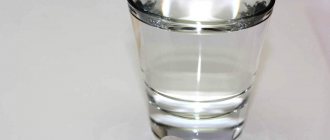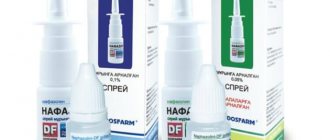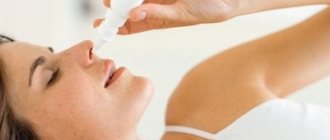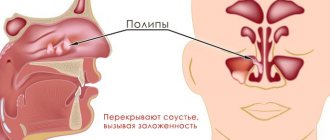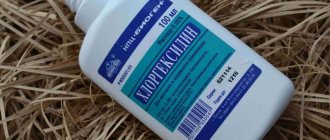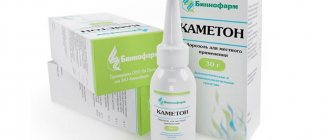Pharmacological properties of the drug Flixonase™
Pharmacodynamics. Fluticasone propionate has a pronounced anti-inflammatory, anti-edema and anti-allergic effect. The anti-inflammatory effect is a consequence of the interaction of the drug with glucocorticoid receptors. Reduces the production of inflammatory mediators, prostaglandins, cytokinins and other biologically active substances during the early and late phases of the allergic reaction. Has a rapid anti-inflammatory effect on the nasal mucosa. The antiallergic effect is observed 2–4 hours after the first use. Reduces sneezing, rhinorrhea, nasal congestion, itching and discomfort in the nasal cavity, relieves eye symptoms associated with rhinitis. The reduction in symptoms persists for 24 hours after using the drug at a dose of 200 mcg. Improves the quality of life of patients. When used in recommended doses, it has no systemic effect and does not inhibit the hypothalamic-pituitary-adrenal system. Pharmacokinetics. With intranasal administration of fluticasone propionate at a dose of 200 mcg/day, the maximum concentration in the blood plasma is not detected in most cases (concentration ≤0.01 ng/ml). The degree of direct absorption of the drug in the nasal mucosa, as well as the total systemic absorption, even taking into account the absorption of the ingested drug, are insignificant. Fluticasone propionate has a large volume of distribution - about 318 l. Blood protein binding is moderately high - 91%. Fluticasone propionate is rapidly eliminated from the systemic circulation, primarily by hepatic metabolism as an inactive carboxyl metabolite via cytochrome CYP 3A4. The main route of drug elimination is excretion through the intestines, mainly unchanged. The renal clearance of fluticasone propionate is negligible (≤0.2%).
pharmachologic effect
Glucocorticosteroid for local use.
The spray suppresses the proliferation of lymphocytes and prevents the division of macrophages. The active component of the corticosteroid reduces the synthesis of prostaglandins, histamine and other inflammatory mediators at different phases of development.
Flixonase quickly eliminates swelling of the mucous membrane and relieves a runny nose. 2 hours after the procedure, the person’s condition improves:
- Reduces itching in the nose.
- There is a feeling of pressure around the eyes.
- Stops sneezing.
- Tearing stops.
- Breathing becomes easier.
The antiallergic effect appears almost immediately. The spray stops the mechanism of inflammation, the effect lasts for a day.
Read how to choose the right tablets for allergic rhinitis here.
Use of the drug Flixonase™
Prescribed only for intranasal use. Adults and children over 12 years of age : - 2 sprays into each nasal passage once a day, preferably in the morning. In some cases, 2 injections into each nasal passage 2 times a day are indicated. Do not exceed the maximum daily dose - 4 injections into each nasal passage. Elderly patients are prescribed the drug in the same doses. Children aged 4 to 12 years : 1 spray into each nasal passage once a day, preferably in the morning. In some situations, 1 injection 2 times a day is required in each nasal passage. It is recommended not to exceed the maximum daily dose (2 sprays in each nostril). Children under 4 years of age : use is not recommended due to the lack of experience in this age group. Elderly patients : the same doses as for adults are used. To obtain the full therapeutic effect, regular use of the drug is necessary. The maximum therapeutic effect develops 3–4 days after the start of treatment, which explains the lack of an immediate therapeutic effect. The duration of treatment is determined by the doctor depending on the patient's clinical condition and response to treatment.
Side effects of Flixonase™
Immune system disorders Very rare: hypersensitivity reactions, anaphylaxis/anaphylactic reactions, bronchospasm, skin rashes, swelling of the face or tongue. From the nervous system : often: headache, unpleasant taste and smell. On the part of the organ of vision Very rarely: glaucoma, increased intraocular pressure, cataracts. From the respiratory system and chest organs Very often: nosebleeds. Common: dryness and irritation of the mucous membrane of the nasal cavity and throat. Very rare: perforation of the nasal septum.
Indications
The instructions for the drug tell us about the following indications for use:
- Treatment and prevention of chronic and seasonal rhinitis of allergic origin.
- Hay fever of the nose.
- Pressure and burning in the sinuses.
- Rhinorrhea.
- Watery eyes, nasal congestion and itching of the nasal mucosa.
The main indication, of course, is allergic rhinitis. Many people are interested in the question of whether it is worth using it in the treatment of sinusitis. If you take into account the instructions, then this cannot be done, since the drug does not have an antibacterial effect. However, it can be used as part of complex therapy for sinusitis, because it effectively relieves the discomfort that accompanies the disease. If we talk about complex therapy, Flixonase, according to reviews, is sometimes prescribed for the treatment of adenoiditis complicated by suffocation and paroxysmal cough.
Special instructions for the use of Flixonase™
Infectious and inflammatory processes in the nasal cavity require appropriate treatment, but are not considered specific contraindications for prescribing Flixonase. If it is necessary to transfer patients from systemic therapy with GCS to the use of Flixonase, caution should be exercised, since there is reason to assume suppression of the function of the adrenal cortex. Long-term use of the drug requires regular monitoring of the function of the adrenal cortex. The patient should be warned that if there is no improvement after 7 days of continuous use of the drug, he should consult a doctor. Continuous use of the drug for 6 months requires medical monitoring of the patient's condition. Although in most cases with seasonal allergic rhinitis, the administration of Flixonase nasal spray is sufficient, in severe cases of the disease (high concentrations of allergens in the summer), additional therapy may be necessary. Children. The use of the drug in children under 4 years of age is not recommended due to the lack of experience in using the drug in this age group. During pregnancy and breastfeeding. When prescribing the drug during pregnancy or breastfeeding, the ratio of the expected benefit to the mother and the potential risk to the child should be assessed. It is unlikely to affect the ability to drive vehicles or operate other machinery.
Indications and contraindications
Flixonase is intended for the treatment of chronic allergic rhinitis or that occurs as a result of short-term exposure to an allergen (seasonal rhinitis).
Eliminates the following unpleasant symptoms:
- Stuffiness, runny nose;
- Sneeze;
- Itching in the nasal cavity;
- Feeling of pain in the paranasal sinuses and around the eyes;
- Tearing.
There are some situations where Flixonase should be used with caution or not recommended at all, such as in children or pregnant or breastfeeding women. Also, the use of the spray is contraindicated for people with frequent headaches, high blood pressure, various eye diseases, impaired brain function, frequent sinusitis, or in the postoperative period on the nose or eyes.
The spray helps prevent the occurrence of allergic rhinitis and is used to treat pathology, regardless of the form in which the disease occurs - chronic or seasonal. Flixonase quickly eliminates runny nose and itching.
The drug is not prescribed for children under 4 years of age.
It is not recommended to use the gel for people who have problems with the integrity of the nasal mucosa, which is damaged as a result of injury or surgery. You should not treat rhinitis with the drug if you have hypersensitivity to any component.
Read this material on how to take Loratadine for allergies.
Side effects rarely occur during drug therapy, which manifest themselves as:
- deterioration of sense of smell;
- headache;
- irritation of the mucous membrane;
- nosebleeds.
This usually happens when the spray is used for a long time or the dosage is exceeded.
If the active component is intolerant, instead of eliminating the inflammation, a rash appears on the skin, the face swells, and the tongue swells.
Interactions of the drug Flixonase™
Given the very low plasma concentrations of fluticasone propionate after intranasal administration due to extensive first-pass metabolism in the liver and high systemic clearance of the drug due to cytochrome P450 3A4 in the liver and intestine, a clinically significant interaction is unlikely. With simultaneous use of Flixonase with ritanavir (a strong inhibitor of cytochrome P450 3A4) it can significantly increase the concentration of fluticasone propionate in plasma, which leads to a significant decrease in the concentration of cortisol in the blood serum, side effects due to the systemic action of corticosteroids develop, including Cushing's syndrome and suppression of adrenal cortex function . Therefore, it is necessary to avoid the simultaneous use of fluticasone propionate and ritanavir, except in cases where the benefits of use will outweigh the risk of systemic effects of corticosteroids. Concomitant use of Flixonase with other cytochrome P450 3A4 inhibitors leads to a slight (erythromycin) or small (ketoconazole) effect on increasing the systemic concentration of fluticasone propionate in the blood serum without a significant decrease in cortisol concentration. However, with the simultaneous use of fluticasone propionate and strong inhibitors of cytochrome P450 3A4 (for example, ketoconazole), caution must be exercised, given the possibility of increased systemic exposure to fluticasone propionate.
FLIXONASE
DOSAGE FORM, COMPOSITION AND PACKAGING
Nasal spray dosed in the form of a white opaque suspension, free of foreign particles.
1 dose of fluticasone propionate (micronized) 50 mcg
Excipients: anhydrous dextrose, microcrystalline cellulose, microcrystalline carboxymethylcellulose, phenylethyl alcohol, benzalkonium chloride solution, polysorbate 80, diluted hydrochloric acid, purified water.
60 doses - dark glass bottles with a dosing device and adapter (1) - cardboard packs. 120 doses - dark glass bottles with a dosing device and adapter (1) - cardboard packs.
PHARMACHOLOGIC EFFECT
GCS for intranasal use. It has a pronounced anti-inflammatory, anti-edematous and anti-allergic effect.
The anti-inflammatory effect is realized as a result of the interaction of the drug with glucocorticosteroid receptors. Suppresses the proliferation of mast cells, eosinophils, lymphocytes, macrophages, neutrophils. Fluticasone propionate reduces the production of inflammatory mediators and a number of biologically active substances (including histamine, prostaglandins, leukotrienes, cytokines) during the early and late phases of the allergic reaction. Has a rapid anti-inflammatory effect on the nasal mucosa. The antiallergic effect appears within 2-4 hours after the first use. Reduces sneezing, nasal itching, rhinorrhea, nasal congestion, discomfort in the sinuses and pressure around the nose and eyes. In addition, it relieves eye symptoms associated with allergic rhinitis. Reduction in the severity of symptoms (especially nasal congestion) persists for 24 hours after a single use of the spray at a dose of 200 mcg.
Fluticasone propionate improves the quality of life of patients, including physical and social activity.
When used in recommended doses, the drug has no systemic effect and practically does not inhibit the hypothalamic-pituitary-adrenal system.
PHARMACOKINETICS
Suction
After intranasal administration of fluticasone propionate (200 mcg/day), Cmax in the blood plasma is not determined in most patients (i.e., less than 0.01 ng/ml). The highest Cmax value is 0.017 ng/ml. Direct absorption from the nasal mucosa is negligible due to the low solubility of the drug in water, as a result of which most of the dose is ultimately swallowed. When taking fluticasone propionate orally, less than 1% of the dose is absorbed into the blood due to low absorption and first-pass metabolism. These reasons are responsible for the extremely low total absorption from the nasal cavity and gastrointestinal tract (of the swallowed drug).
Distribution
When fluticasone propionate reaches Css in plasma, it has a significant Vd - about 318 l.
Plasma protein binding is about 91%.
Metabolism
Fluticasone propionate undergoes a “first pass” effect through the liver and is metabolized with the participation of the CYP3A4 isoenzyme to form an inactive carboxyl metabolite.
Removal
It is excreted mainly in bile unchanged and in the form of metabolites.
INDICATIONS
— prevention and treatment of seasonal allergic rhinitis;
— prevention and treatment of year-round allergic rhinitis.
DOSING REGIME
Flixonase is intended for intranasal use only. To achieve the full therapeutic effect, the drug should be used regularly.
Adults and children over 12 years of age are prescribed 100 mcg (2 doses) in each nostril 1 time/day (total dose 200 mcg/day), preferably in the morning. After achieving control of symptoms, you can prescribe 50 mcg (1 dose) in each nostril 1 time / day (total dose 100 mcg / day).
In some cases, it is necessary to use 100 mcg (2 doses) in each nostril 2 times / day (total dose 400 mcg / day) for a short time in order to achieve control of symptoms, after which the dose can be reduced. The maximum daily dose of the drug is 400 mcg (4 doses in each nostril).
Elderly patients do not require dosage adjustment.
For children aged 4-12 years, it is recommended to administer 50 mcg (1 dose) in each nostril 1 time/day. The maximum daily dose of the drug is 200 mcg (2 doses in each nostril).
The maximum therapeutic effect appears after 3-4 days of therapy. To achieve the full therapeutic effect, it is necessary to use the drug regularly.
Mode of application
Before use, shake the bottle carefully, take it by placing your index and middle fingers on either side of the tip, and your thumb under the bottom. When using the drug for the first time or a break in its use for more than 1 week, you should check the serviceability of the sprayer (pointing the tip away from you, make several presses until a small cloud appears from the tip).
Next you need:
- clear your nose (blow your nose lightly);
- close one nostril and insert the tip into the other nostril;
— tilt your head slightly forward, continuing to hold the aerosol bottle vertically;
- begin to inhale through your nose and, continuing to inhale, press once with your fingers to spray the drug;
- exhale through your mouth.
Repeat the procedure for a second spray in the same nostril, if necessary. Next, repeat the described procedure completely, inserting the tip into the other nostril.
After use, blot the tip with a clean napkin or handkerchief and close it with the cap.
The sprayer should be washed at least once a week. For this purpose, you must carefully remove the tip and rinse it in warm water. Shake off excess water and leave to dry in a warm place. Avoid overheating. Then carefully place the tip in its original place at the top of the brown bottle. Put on the protective cap. If the tip hole is clogged, the tip should be removed as described above and left in warm water for a while. Then rinse under running cold water, dry and put back on the bottle. Do not clean the tip hole with a pin or other sharp objects.
SIDE EFFECT
Local reactions: dryness and irritation of the nasopharynx, unpleasant taste and smell, nosebleeds, burning sensation, nasal congestion; very rarely (less than 1/10,000 cases) - perforation of the nasal septum (especially with a history of surgical interventions in the nasal cavity).
Allergic reactions: possible skin rash, swelling of the face and tongue; very rarely (less than 1/10,000 cases) - anaphylactic reactions and bronchospasm.
Other: headache.
CONTRAINDICATIONS
- children under 4 years of age;
- hypersensitivity to fluticasone propionate and other components of the drug.
The drug should be used with caution if you have herpes, as well as an infection of the nasal cavity or paranasal sinuses. Infectious diseases of the nose require appropriate treatment. Infectious diseases of the nose are not a contraindication for the use of Flixonase.
The drug should be prescribed with caution after a recent injury to the nose or after surgery in the nasal cavity, as well as in the presence of ulcerative lesions of the nasal mucosa.
Flixonase should be prescribed with caution simultaneously with inhibitors of the CYP3A4 isoenzyme (including ritonavir, ketoconazole), since these drugs may cause an increase in the concentration of fluticasone propionate in plasma.
Caution should be exercised when prescribing the drug concomitantly with other dosage forms of corticosteroids, including tablets, creams, ointments, drugs for the treatment of bronchial asthma, similar nasal or eye sprays and nasal drops.
PREGNANCY AND LACTATION
It is not recommended to prescribe Flixonase during pregnancy. If it is necessary to use the drug in this category of patients, the expected benefits of therapy for the mother and the potential risk for the fetus should be taken into account.
SPECIAL INSTRUCTIONS
Caution must be exercised when transferring patients from systemic corticosteroid therapy to treatment with Flixonase if there is reason to suspect adrenal dysfunction.
With long-term use of the drug, regular monitoring of adrenal function is required.
The patient should be warned that if there is no improvement after 7 days of continuous use of the drug, he should consult a doctor.
With continuous use of the drug for more than 6 months, medical monitoring of the patient's condition is necessary.
In most cases, the use of Flixonase can successfully control the symptoms of seasonal allergic rhinitis, but in some cases, with very high concentrations of allergens in the air in the summer, additional therapy may be required.
To relieve ophthalmological manifestations against the background of successful treatment of seasonal allergic rhinitis, additional treatment may be required.
OVERDOSE
No symptoms of acute or chronic overdose of the drug have been recorded. When administered intranasally to healthy volunteers, 2 mg of fluticasone propionate 2 times a day for 7 days did not reveal any effect on the function of the hypothalamic-pituitary-adrenal system.
DRUG INTERACTIONS
Due to the very low plasma concentrations of fluticasone propionate after administration of Flixonase, a clinically significant interaction is unlikely.
With simultaneous use of Flixonase with ritonavir, which is a strong inhibitor of the CYP3A4 isoenzyme, a significant increase in the concentration of fluticasone propionate in the blood plasma is possible. As a result, there is a sharp decrease in serum cortisol concentrations and side effects due to the systemic action of corticosteroids develop, including Cushing's syndrome and suppression of adrenal function.
With simultaneous use of Flixonase with other inhibitors of the CYP3A4 isoenzyme, a negligible (with erythromycin) or insignificant (with ketoconazole) increase in the concentrations of fluticasone propionate in the blood plasma is observed, which does not cause a noticeable decrease in serum cortisol concentrations.
CONDITIONS OF VACATION FROM PHARMACIES
The drug is available with a prescription.
CONDITIONS AND DURATION OF STORAGE
List B. The drug should be stored at a temperature not exceeding 30°C. Shelf life – 2 years.
Flixonase™ drug overdose, symptoms and treatment
Symptoms of acute or chronic overdose are not described. Intranasal administration of fluticasone propionate to healthy volunteers at a dose of 2 mg 2 times a day for 7 days did not affect the function of the hypothalamic-pituitary-adrenal system. Long-term use of large doses may lead to temporary suppression of adrenal function. In such patients, treatment with fluticasone propionate should be continued at doses sufficient to control symptoms. Adrenal function will recover in a few days, which can be checked by determining the level of cortisol in the blood plasma.

